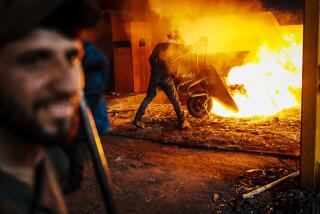Where the Cold War Continues
- Share via
NEW YORK — With Secretary of State Madeleine K. Albright’s visit to Hong Kong and newly capitalist Vietnam, U.S. Asia policy seems firmly based in the east. But if the United States wants to pursue real progress in Asia, Albright should cast her eye westward toward Afghanistan, where the Cold War is still tenacious and unforgiving. As a result of the protracted Afghan war, south and central Asia remain unstable, and crucial relationships with Russia, Iran and the Indian subcontinent are imbalanced. U.S. policy is caught in long-standing mistakes and contradictions, and the time is ripe for Albright to help correct them.
Like the hole in a doughnut, Afghanistan defines its region without being present in policy calculations. While the country seems far from the minds of policy-makers, who still regard it as an empty vessel for outside interests, Afghanistan faces complex emergencies resulting from almost two decades of war. Poverty, malnutrition, disease, unemployment and millions of land-mines define Afghanistan’s political landscape. But its neighbors and advisors ignore these realities, self-defeatingly setting their own, short-term interests above the victims of the Cold War’s last bastion.
Recent events support this prognosis. In May, a short burst of fighting appeared momentarily to have settled the question of who controls Afghanistan in favor of the militantly Islamist Taliban movement. Serendipity, personal animosities and temporary military superiorities favored the somewhat more secular anti-Taliban forces in northern Afghanistan. Today, both sides--and their diverse outside supporters--live in wary stalemate while preparing for new offensives.
The Taliban first moved into southern Afghanistan in late 1994 to remove the rule of rapacious local commanders. Known for frequent, often idiosyncratic, edicts to enforce its version of Islamic rule, the Taliban brought a semblance of order to southern Afghanistan by restoring the importance of tribal elders and erasing the last vestiges of communism. Its combination of centralized dictates and decentralized control has established an uneasy quiet from Herat to Kabul.
But one man’s communism may be another woman’s chance for equality: The price of security in Taliban-held areas is the suspension of free choice. Women are largely banned from public life; girls no longer have the right to an education, and men and women alike are forced to conform to conservative social norms. Northern Afghanistan--under the rule of more secular, if self-interested, local commanders--is understandably leery of Taliban incursions.
The people of Afghanistan have not been asked to ratify Taliban military successes, to vote on edicts and commandments or to validate local rulers. Dissent has been muted during war: No one knows how Afghans really feel about any of their rulers.
And Taliban leaders seem willing to bypass Afghan opinion in favor of outsiders. They easily ignore international human-rights standards--hiding behind the veil of religious injunction--and count on the world to do so, too. Taliban leaders are frantically lobbying the U.N. and member states for formal recognition, hoping to solidify their rule with international cooperation rather than popular mandate.
Such attention to the will of outsiders continues the tragic history of external interference that has long colored Afghanistan’s destiny. The past few years have seen perpetual meddling from central Asia, Iran and Pakistan. The 10-year U.S.-Soviet proxy war, launched in part from Pakistani soil, spawned horrific destruction, from which the country has yet to recover. The withdrawal of Soviet troops in 1989, and several years of destructive divisiveness and vicious fighting among factions, opened the gates to foreign meddling once again. Now, the Pakistan and Gulf-supported Taliban are countered by forces aided by front-line central Asia, Iran and Russia. Afghanistan is more fragmented than in 1989. Its increasing vulnerability to outside influences intensifies local antagonisms and makes peace an elusive hope.
The United States and Russia, both a bit further behind the scenes now than in the 1980s, are repeating old, failed policies. As before, each backs, then often discards favored proxy players with the hope that their own interests, including gas and oil pipelines, can be furthered through their chosen political and military factions.
The old U.S. policy of containing Soviet power is now translated into containing Russia by separating it from the resources of its southern and central Asian neighbors. Russia, in turn, seems keen to maintain a central Asian sphere of influence; its troops have been stationed close to the Tajikistan-Afghan border for several years. As Russia struggles to develop new relationships with Persian Gulf states, U.S. policy still isolates Iran. Many Afghans believe that U.S. belligerence toward Iran leads it to support the Taliban--but in Iran, they see political pluralism that is only a distant dream for Afghans themselves.
Washington coyly claims only to want a central authority to rule Afghanistan, but seems not to trust Afghans to settle this issue themselves. U.S. posturing and mercantile behavior belie its claims to neutrality in Afghan power struggles. Now, a U.S.-based oil company is courting the Taliban to secure contracts to build a pipeline across the country. But in Afghanistan, as elsewhere, dollar diplomacy can only be shortsighted.
The Afghan proxy game now threatens the delicate amiability of post-Cold War relationships. Ideological, ethnic and religious contests inside Afghanistan have dangerous repercussions outside, among Tajiks and Uzbeks, Shias and Sunnis, secularists and Islamists.
Pakistan’s domestic and regional equilibrium is already threatened by its Afghanistan policy: Its vaunted reputation as a moderate, modernizing Islamic interlocutor between East and West is gravely compromised by its Afghanistan gambit. The same divisive and militant Islamic groups that operate in Afghanistan and Kashmir now find their prey inside Pakistan as well. Tajikistan, Uzbekistan, Turkmenistan and Iran, concerned variously about refugees, Islamist influences, the pursuit of profit and Shia-Sunni tensions, may well face similar blow-back from their Afghan policies.
As long as geopolitics dominates Afghanistan, war cannot end. Caught between poverty and insecurity, beholden to those who have taken power and divided by ideologies often not their own, Afghans have lost hold of their future. It can be regained, but only if Afghans are left to solve their own problems--to choose the Taliban, if they wish, or others, but to do so without the interference of outsiders.
This is the moment for the United States to lead the way out of Afghanistan. If Washington is not directly involved, as it claims, it can lead by example, in the name of peace and regional harmony. If it is complicit in Afghan power plays, even tacitly, then all the better: It can change course to join hands with Russia and the region to help Afghanistan regain its sovereignty. Persuasion, sanction, enticement and a promise of cooperative rehabilitation assistance helped to remove nuclear weapons from central Asia. Surely, ending war is equally urgent.
The Cold War in Asia has had a long run. It’s time to make it end.
More to Read
Get the L.A. Times Politics newsletter
Deeply reported insights into legislation, politics and policy from Sacramento, Washington and beyond. In your inbox twice per week.
You may occasionally receive promotional content from the Los Angeles Times.










